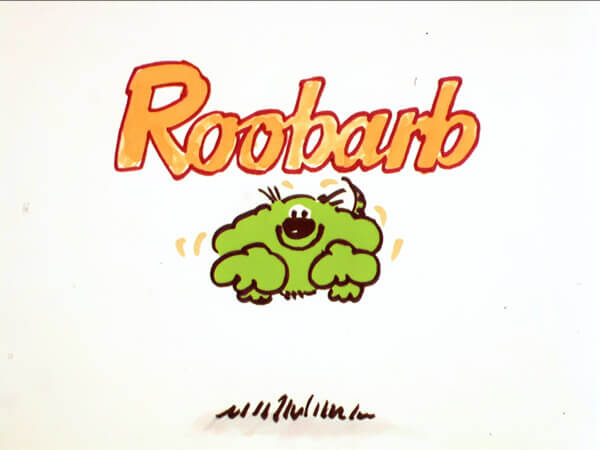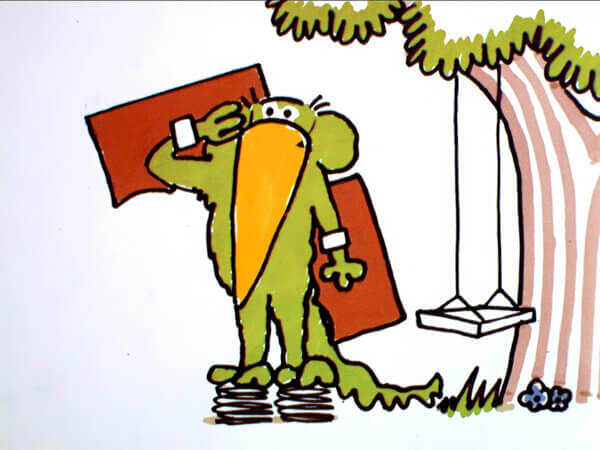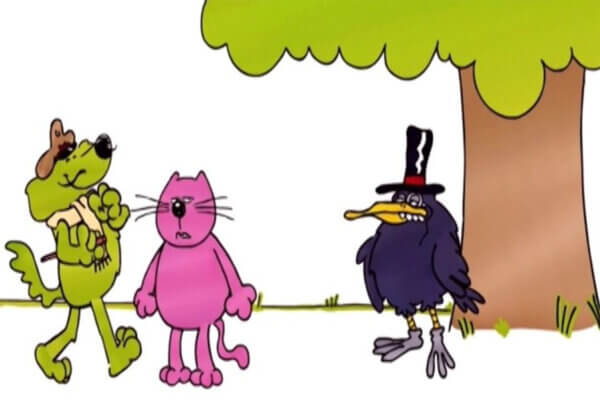Roobarb’s 50 Years of Misadventures and Antics
Ever since Roobarb was introduced to audiences on the BBC on Monday the 21st of October in 1974, he captivated everyone as his first episode, When Roobarb Made A Spike, presented himself as a curious dog who tried to get the worms out of the ground the same way the birds do, eventually dressing up as one before getting stuck in the dirt and laughed at by the giggling feathered fiends and Custard the Pink Cat that lives next door. This dog, who loves experimenting and exploring new things in the world of his back garden, not only captivated the people at the BBC, but entertained and was beloved by its audience too.
This year marks fifty years since that first episode. In that time, the original series enjoyed countless re-runs and re-releases through the following decades for new generations of fans and a revival in the early 2000s. The success of Roobarb wouldn’t have been possible without the input of its creator and writer, Grange Calveley (1943 to 2021,) and its director and animator, Bob Godfrey (1921 to 2013,) both of which created one of the most iconic characters in British animation with its charming stories and it’s unique approach to animating the world of the hallowed hound.

The title screen from Roobarb
In the early 1950s, Bob Godfrey worked as a background artist at Larkins Studio, who were known for their work on their informative and creative short films such as River of Steel for the British Iron and Steel Foundation. Godfrey had no prior animation experience but had talent as a painter for various products and merchandise for animated productions from Gaumont-Animation Studio. However, it never stopped him from trying to expand his skill set during his time at Larkins Studio and he collaborated with other artists and animators from the studio in their spare time, leading Godfrey to direct his first short films, The Big Parade (1952,) and Watch the Birdie (1954.)
After a few years of gaining the support and experience needed for animation, Godfrey left Larkins Studio to set up Biographic Cartoons in 1955 with some of his colleagues whom he collaborated with previously. Their early productions consisted of televised adverts. They gained traction after these were broadcasted on ITV during its infancy and led the studio to animating sequences for ITV’s comedy series Son of Fred. And all while their equipment consisted of a hand-cranked 1909 Moy & Bastie Camera attached to two tables that held their artwork, which was certainly more budget-friendly compared to the high-end technology and production values that Walt Disney Animation Studios was producing and experimenting with at that time for their theatrical releases.
A decade later, Bob Godfrey left Biographic Cartoons to set up a studio by himself in 1965, named Bob Godfrey’s Movie Emporium, producing short scripts penned by Stan Hayward and it wasn’t until 1971 that he saw his only financial success during those early few years for his studio with his adult animated short film, Kama Sutra Rides Again, after it had been selected by Stanley Kubrick himself to have it screened before A Clockwork Orange, which would become one the famed auteur director’s more iconic pieces of work and would gain traction during its theatrical run for its controversial scenes and sexual depravity.

When Roobarb Made a Spike
But while Godfrey was going through his challenges and achievements with his new studio, Grange Calveley was going through his own obstacles on his journey to become a television writer. Working in advertising during the 1960s, Calveley met his future wife and eventually, they both purchased a house together. It would be his new family member who would inspire him to eventually try his hand at writing for children’s television: a pet dog, a Welsh Border Collie, to be more accurate. Witnessing its playful nature, love for climbing a big tree, and even helping to “water” the rhubarbs, led Calveley on a journey to create his character. Designing Roobarb the Green Dog and coming up with potential stories to tell with scripts and storyboards, he tried to pitch it to the BBC and eventually, they agreed for him to make a pilot, which led to the partnership of Calveley and Godfrey.
Compared to other shows in the early 1970s, Godfrey’s studio had a low budget to produce the pilot, using marker pens to draw each panel of the limited animation used. To give it the effect of movement, Godfrey used the technique known as “boiling,” where each panel or frame is drawn to give the illusion of movement when edited and played together, which would eventually be used across the entirety of the show. With such a large and diverse range of characters and shows in the early 1970s from around the world now taking over television sets to compete with, including Scooby-Doo and Super Friends from Hanna-Barbera Productions, The Wombles from Ivor Wood, Star Trek: The Animated Series from Filmnation, and Mr Benn from David McKee, children already had a plethora of diverse content and genres within animation to enjoy.
Despite their lack of resources, Godfrey and Calveley were able to complete their short pilot, which was titled When Roobarb Made a Spike, and was screened at the National Film Theatre in 1973 before the BBC decided to turn it into a television series consisting of thirty episodes. With the combined efforts of the writer and director along with their production team to create recognisable and emotive characters, Richard Brier’s expressive narration, and a catchy and unique theme song by Johnny Hawksworth, the series became a family favourite and an iconic piece of British children’s television in the decade.
Despite only being made up of thirty episodes, it brought the creator and director huge success. They would collaborate once again for another animated series for the BBC, this time with Noah and Nelly in SkyLArk, a surreal series loosely based on Noah’s Ark. While the two may not have collaborated again and went on to work on their own projects, Roobarb was still beloved by those who grew up with him and with the emergence of home media formats like VHS and DVDs, those same children, now grown up, could introduce it to the next generation.
With the arrival of the 21st century, Grange Calveley wanted to return to his beloved creation and create brand new stories for young children and adults to enjoy. Now partnering with Channel Five for their children’s slot, Milkshake, instead of returning to the BBC, the new iteration of the series would see some changes. This time, Roobarb would not be alone as he would share the title and screen with Custard the Pink Cat for Roobarb and Custard which was broadcast in 2005. While it saw the two continue their misadventures and wacky approaches to discoverability with modern animation technology and techniques involved, it also saw them tackle modern technology in some episodes as well as introduce a whole cast of brand-new characters.
While Godfrey and Calveley may no longer be with us to celebrate the accomplishment of their beloved creation, fans of the beloved cast of characters and their iconic shows can still enjoy their works after all these years. Whether that would be dusting down some old VHS tapes or streaming it on YouTube or ITVX, fans of this British classic series should sit down and rediscover just what it was that makes the curious green dog so compelling and loveable fifty years on.
Earlier this year, Fabulous Films released the complete collection of ‘Roobarb’ and ‘Roobarb and Custard Too’ on a fully restored Blu-ray edition. Roobarb and Custard The Complete Collection [Blu-ray] is now available from Amazon.


